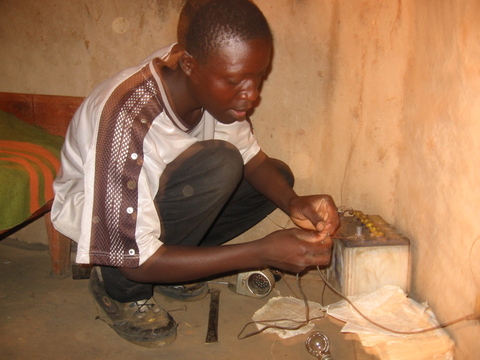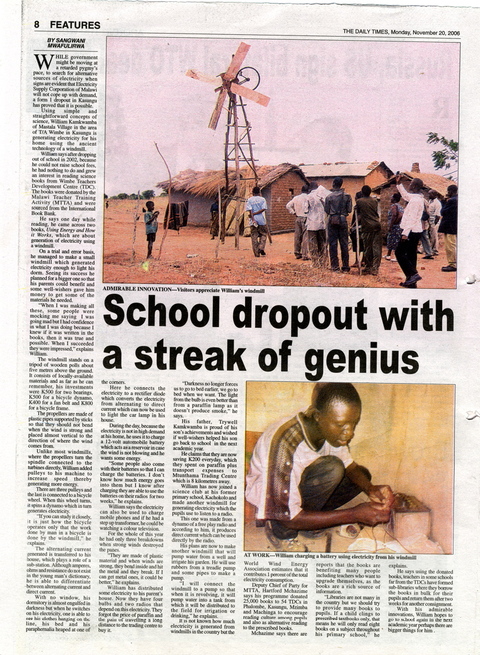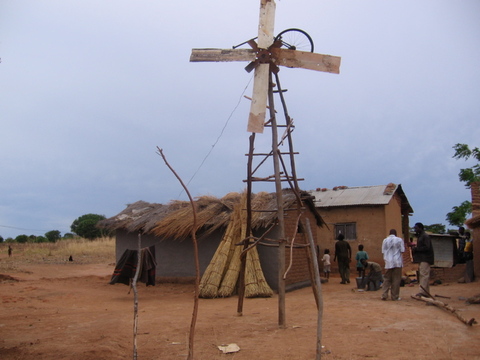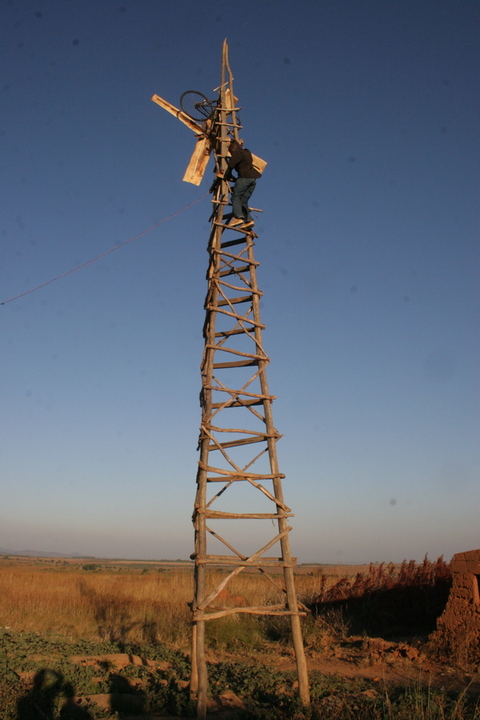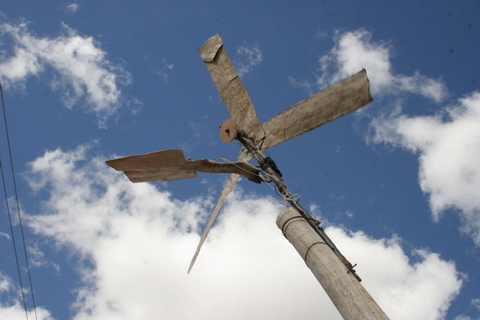Here is the first article from the Malawi’s The Daily Times, November 20, 2006. Sangwani has now left the Daily Times to work at a media NGO that promotes freedom of the press called Media Institute of Southern Africa or MISA.
School dropout invents windmill electricity
BY SANGWANI MWAFULIRWA
While government might be moving at a retarded pygmy’s pace to search for alternative sources of electricity when signs are evident that Escom will not cope up with increasing demand, a form 1 dropout in Kasungu has proved that it is possible.
Using simple and straightforward concepts of science, William Kamkwamba of Mastala Village in the area of T/A Wimbe is generating electricity for his home using the ancient technology of a windmill.
William says after dropping out of school in 2002, because he could not raise schools fees, he had nothing to do and grew an interest in reading science books from Wimbe Teachers Development Centre (TDC). The books were donated by the Malawi Teacher Training Activity (MTTA) and were sourced from the International Book Bank.
He says one day while reading he came across two books, “Using Energy” and “How it Works” which talked about how to generate electricity using a windmill and was motivated to try it.
On a trial and error basis he managed to make a small windmill which generated electricity enough to light his little dom. Seeing its success he planned to make a bigger one so that his parents too could benefit and some well-wishers gave him money to get some of the materials he needed based on his innovativeness.
“When I was making all these people were mocking me that I was driving mad but I had confidence in what I was doing because I knew if it was written in the books then it was true and possible. When I succeeded they were impressed,” explains William.
The windmill stands on a tripod of wood polls about five metres above the ground. It consists of locally-available materials and as far as he can remember his investments were K500 for two bearings, K500 for a bicycle dynamo, K400 for a fun belt and K800 for a bicycle frame.
Back in November, the windmill was only 5 meters (15 feet) tall compared to 12 meters (36 feet) today. I raised the height because I discovered that the best wind was just over the top of the shorter windmill.
The windmill today. I moved the location away from the house to avoid damage in case of mishap.
The propellers are made of plastic pipes supported by sticks to that they should not bend when the wind is strong and placed almost vertical to the direction the winds is coming.
Unlike in most windmills where the propellers directly turn the spindle connected to the turbines directly, William added pulleys to his machine to increase speed thereby generating more energy.
There are three pulleys and the last is connected to a bicycle wheel. When this wheel turns it turns a dynamo which in turn generates electricity.
“If you can study is closely it is just as how the bicycle operates only than the work done by man in a bicycle here it is done by the windmill,” he explains.
The alternating current generated is transferred to his house, which plays a role of a substation. Although amperes, ohms and resistance do not exist in the young man’s dictionary, he is able to differentiate between alternating current and direct current.
With no window, his dormitory is almost engulfed in darkness but when he switches on his electricity, one is able to see his clothes hanging on the line, his bed and his paraphernalia heaped at one of the corners.
Here he connects the electricity to a rectifier diode which converts the electricity from alternating to direct current which can now be used to light the car lamp in his house.
During day time because the electricity is not in high demand at his home he uses it to charge a 12-volt automobile battery which acts as a reservoir in case the wind is not blowing and he wants some energy.
“Some people also come with their batteries so that I can charge them. I don’t know much energy goes into them but I know after charging they are able to use their battery listening to the radio for two weeks,” he explains.
William says the electricity can also be used to charge mobile phones and if he could have a step up transformer he could be able to watch a colour television.
For the whole of this year he had only three breakdowns because strong winds destroyed the panes. “They are made of plastic and when winds are strong they bend inside and hit the metal breaking in the process. If I can get metal ones it could be better,” he explains.
As the speed of the dynamo increases, so is the rate of alternating current. This is good as it is stored in the battery that is being charged and is used at night or anytime when there are winds.
William has distributed some electricity to his parent’s house. Now they have four bulbs and two radios that depend on this electricity. They forgot the price of paraffin and the pain of riding a long distance to the trading centre to buy it.
“Now we don’t sleep because of darkness but we go to bed when we want. The light from the bulb is even better than from a paraffin lamp as it doesn’t produce smoke,” he says.
His father, Trywell Kamkwamba is all proud of his son’s achievements and wished if well-wishers could help him go back to school again next academic year.
He claims that they are saving K200 and some transport money which they were using to buy paraffin from the Mtunthama Trading centre which is 8kms away.
William has now joined a Science Club at his former primary school, Kachokolo and made another windmill for generating electricity which the pupils use to listen to a radio.
This one was made from a dynamo of a free play radio and according to him it produces direct current which can be used directly by the radio.
This is a recent (June, 2007) photo of the smaller windmill at my former primary school in Wimbe
His plans are now to make another windmill that will pump water from a well and irrigate his garden. This will be done by using rubbers from a treadle pump and some pipes to make a pump.
“I will connect the windmill to a pump so that when it is revolving it will be turning the pumping water into a tank from which it will be distributed to the field for irrigation or drinking,” he explained.
It is not known how much electricity is generated from windmills in the country but the World Wind Energy Association estimates that it contributes 1 percent of the total electricity consumption.
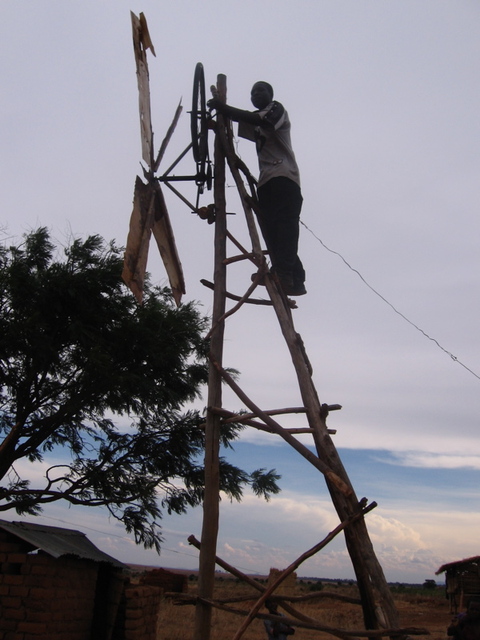
making minor repairs (all photos Nov 06 by SANGWANI MWAFULIRWA except primary school and current windmills)
Deputy Chief of Party for MTTA, Hartford Mchazime says his programme donated 25,000 books to 54 TDCs in Phalombe, Kasungu, Mzimba and Machinga to encourage reading culture among pupils and also as alternative reading to the prescribed books.
Mchazime says there are reports that the books are benefiting many people including teachers who want to upgrade themselves as the book are proving to be a rich source of information.
“Libraries are a scarce commodity in the country but we should try to expose pupils to as many books as possible. If a child clings to prescribed textbooks only, that means he will only read eight books on a subject throughout his primary school,” he explains.
He says using the donated books teachers in some schools far from the TDCs have formed sub-libraries where they borrow the books in bulk for their pupils and return after two weeks for another consignment.
In his free time, William also does minor repair to people from his area and hopes if he finds money might return back to school next academic year.

